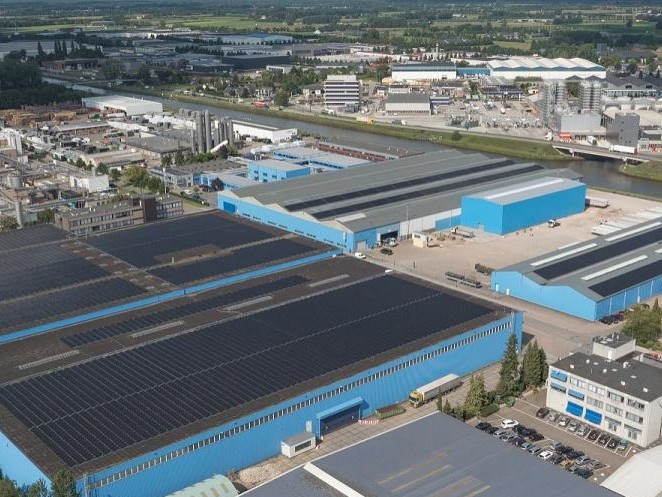Here comes the sun
The Materials Services business area is putting an end to harmful emissions with one of the largest solar energy project in the Netherlands. In the process, its customers can also improve their carbon footprint.
The equivalent of nine soccer fields – that’s the amount of space needed for 13,000 solar panels, which were installed on the rooftops of two subsidiaries in the Netherlands by thyssenkrupp Materials Nederland, a company of the Materials Services business area.
The Veghel and Zwijndrecht locations will be generating more than two-thirds of their energy using solar power. The partner Greenchoice will supply the rest of the power needed using renewable energies. The other branches of thyssenkrupp Materials Nederland are using 100% green energy as well.
Spanning an area of 64,000 square meters, the power plant is currently one of the largest solar power project in the Netherlands, with an annual projected capacity of 2.3 megawatts. Yet Materials Services business area did not need to make any investments. KiesZon, Greenchoice’s partner, assumed the costs of procuring and building the solar power plant. thyssenkrupp Materials Nederland will be able to purchase it in ten years, and become its own power supplier.
Weatherproof roof, lower heat loss
The business area is also working in other ways to maintain a low carbon footprint in the Netherlands. For example, the lighting at some locations has been replaced with energy-efficient LED technology. Further, the sanding machines use special air filters to ensure that the exhaust air is as clean as possible. Biodegradable oil-based products are chosen over conventional products where possible. Suppliers are instructed to use environmentally friendly packaging for their deliveries. All this effort and dedication is not going unnoticed. The solar power project is a hopeful candidate for the thyssenkrupp innovation award.
thyssenkrupp in Bronschhofen, Switzerland, is also fully aware of the fact that rooftops can help cut energy costs. Here thyssenkrupp Materials Switzerland has sections of production hall No.7 and the high-rack storage facility (1,330 square meters in total) refurbished. Multilayered insulation and better sealed skylights were installed. How big are the savings? The amount of heat released was cut in half.
Energy-efficient city hallmark
The Materials Services business area is also helping its customers to cut energy costs. For example, the business area, together with thyssenkrupp Plastics, modernized the Telekom logos on the telecommunications tower in Cologne. The main challenge here was to reproduce the correct color using LEDs. In the end, it was possible with the right mix of blue and red LEDs. Now the three Telekom logos shine out into the night sky over the city in the specific shade of magenta used by the company, while consuming far less energy.
Weatherproof roof, lower heat loss
The business area is also working in other ways to maintain a low carbon footprint in the Netherlands. For example, the lighting at some locations has been replaced with energy-efficient LED technology. Further, the sanding machines use special air filters to ensure that the exhaust air is as clean as possible. Biodegradable oil-based products are chosen over conventional products where possible. Suppliers are instructed to use environmentally friendly packaging for their deliveries. All this effort and dedication is not going unnoticed. The solar power project is a hopeful candidate for the thyssenkrupp innovation award.
thyssenkrupp in Bronschhofen, Switzerland, is also fully aware of the fact that rooftops can help cut energy costs. Here thyssenkrupp Materials Switzerland has sections of production hall No.7 and the high-rack storage facility (1,330 square meters in total) refurbished. Multilayered insulation and better sealed skylights were installed. How big are the savings? The amount of heat released was cut in half.
Energy-efficient city hallmark
The Materials Services business area is also helping its customers to cut energy costs. For example, the business area, together with thyssenkrupp Plastics, modernized the Telekom logos on the telecommunications tower in Cologne. The main challenge here was to reproduce the correct color using LEDs. In the end, it was possible with the right mix of blue and red LEDs. Now the three Telekom logos shine out into the night sky over the city in the specific shade of magenta used by the company, while consuming far less energy.
The Materials Services business area is using one of the biggest solar projects in the country to make itself independent of climate-harming energy. But customers are also being helped to reduce their carbon footprint.
